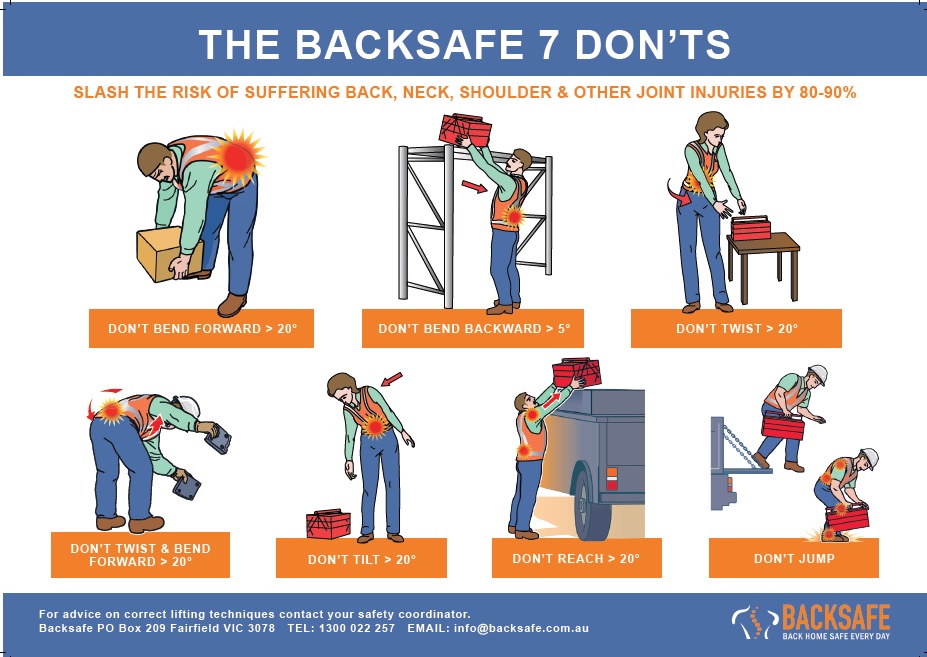A common issue we see throughout our manual handling training, is the lack of strong spinal structure when lifting. One of the most important things to remember when manual handling, is to not use your spine as a lever.
The spine is designed to work most efficiently in a straight up and down motion. Similar to the column of a building, the spine is designed for efficient load from above (compressive strength). To accommodate for motion in everyday living, the spine has four specially designed curves to absorb the shock which are best absorbed in this upright position.
Manual handling techniques for a safer spine
In terms of manual handling, when lifting, pulling, pushing or carrying a load, it is important to use your spine as a column and not as a lever.
When you keep your spine in an upright position while lifting, the weight of the load is transferred evenly and predictably through the spinal column and legs all the way to the ground. This creates a far superior support for your entire body and creates a safer lifting technique.
Unfortunately, most people however, use their spine as a lever when lifting, rather than maintaining the upright column.
Bending the spine
When the spine and torso are used as a beam to bend forward, outwards, or to the side, and then further engaged as a lever to lift a load, the weight of the upper body plus the weight of the load concentrates pressure on the lower discs of the spinal column, muscles, tendons and ligaments in the lower back.
This can cause the discs to microscopically crack and tear over time under the force of this type of loading.
The lowest discs of the spine normally support half the body’s weight – approximately 45 kg for a person weighing 90kg say. When that weight is exerted on the discs in an upright posture, the pressure on the discs is distributed evenly through-out the spinal column.
However, when bending forward you increase this pressure on the lower back structure, the discs by the multiplying effect of leverage.
The further you bend forward, the greater the pressure on your lower discs.
Bending this far forward increases the pressure on the discs up to ten times the upper body weight – and this is without a load.
When you pick up say a 20kg load bent over like this, the pressure on the lower back and the discs may increase to up to 650kg.
Over time this will damage the entire lower back and spinal structure.
The discs will tear and weaken making it impossible for the discs’ nuclei to stay intact.
The joints within your spine will become inflamed, the discs will thin, and the vertebrae will then develop bony outgrowths.
Potential damages to your spinal column
With incorrect lifting techniques, spinal nerves can become thinned and damaged, causing loss of function in the tissue, organs and cells of the body beyond the damaged or obstructed nerve. This can cause intolerable pain and muscle spasms. It can also cause long-term health problems and anxiety.
As the manual handler begins to stand to the erect position, the pressure on the lower discs begins to reduce.
Now while standing erect, holding the load close to the body, he/she supports the body weight plus the 20kg load. In this example that would be 65kg. Standing and/or carrying a load close to the body will generally not damage the lower back unless done excessively. If a mechanical aid is available, it is always advisable to use it.
Key techniques to remember
It’s essential that when lifting in a manual handling setting, or any other setting for that matter, that you do not use your spine as a lever. Remember these important techniques each time to prepare to lift a heavy object.
- Keep your spine in an upright position
- Keep the load close to your body, to avoid unnecessary strain on joints and muscles.
- Use mechanical aids where possible
Following these simple techniques will allow your spinal health to work as it should within the workplace and in your personal life.
Looking for Manual Handling training in your workplace? Contact us today to get a quote.




